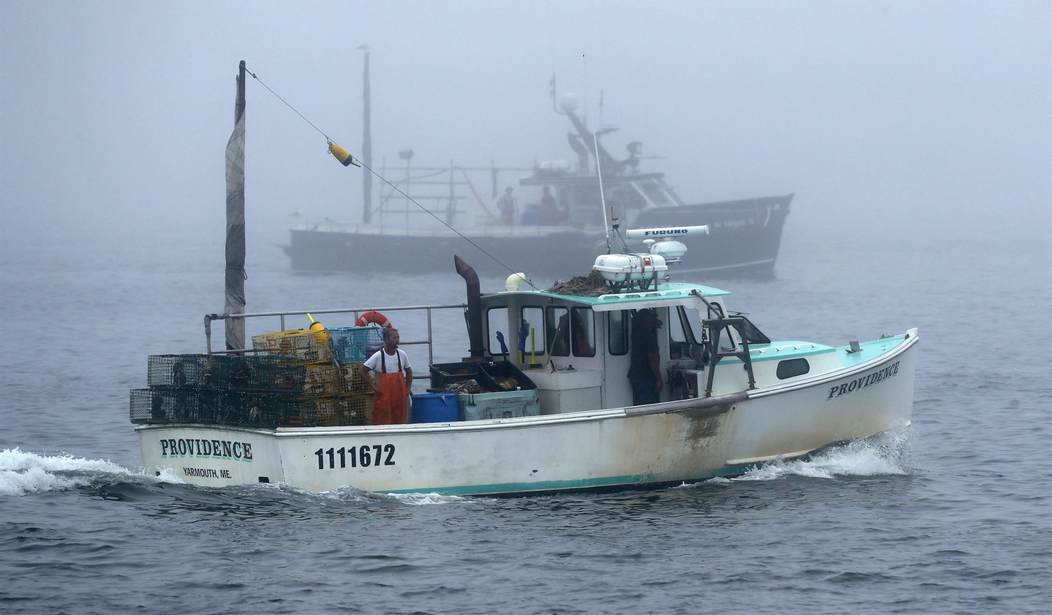Back in 2021, the National Marine Fisheries Service, part of the National Oceanic and Atmospheric Administration (NOAA), issued an opinion in pursuit of preserving the endangered right whale. As these edicts go, this “opinion” has basically force of law when it comes to imposing conservation-based measures, rules and restrictions.
The right whale, which has a population hovering at a tad less than 350 individuals, has been a focus of efforts for some years. The lobster industry, reviled by many environmentalists, became an easy target for a revised set of regulations when the Biden administration took over. And they hammered them.
…At the heart of the case is a set of much-debated regulations, including new gear-marking mandates, a reduction in the number of vertical lines in the water, the insertion of weak points in rope, and a seasonal closure of a nearly 1,000-square-mile area off the Gulf of Maine.
The rules – and the subsequent judgement upholding them in 2022 – were supposed to be “biology-based,” leading one to believe there was some sort of justified and verifiable science involved besides just antipathy to lobstermen in general, all aimed at destroying their industry.
It started to get a little squishy on the rationale details almost from the beginning.
…The rules were the first of three phases designed to reduce the risk to the whales by 98% in 10 years. But opponents have said that level of risk reduction would simply shift the extinction scenario from the whales to the lobster industry. Fishermen have long contended that right whales are not in Maine waters, and there has never been a right whale death attributed to Maine’s lobster industry.
Environmentalists, however, have argued that just because a death hasn’t been linked to the fishery doesn’t mean it hasn’t happened; a historical lack of gear marking has made it difficult to determine where an entanglement occurred.
All documented entanglements from 2016 to 2018 were linked to Canadian gear. Of the entanglements the fisheries service couldn’t attribute to a specific country, half were assigned to the U.S. and half to Canada.
The fisheries service has admitted that the analyses could be more precise, but argues their conclusions were still reasonable.
Ah. REASONABLE conjecture is the basis on which one proposes destroying an entire industry?
And “just because you didn’t see it doesn’t mean it didn’t happen” hasn’t worked as an excuse since I was a kid, less mind what these government employees are getting paid to come up with that tripe.
Yes. That and Science™. Check their #mathz.
…Because the fisheries service said from the beginning that, when confronted with unknowns it would generally presume the worst scenario for the whales, all their assumptions were tainted, he said.
The conclusion that the fishery kills 46 whales per decade is a “staggering departure from the two documented deaths known to have originated in all U.S. fisheries over a period of nine years,” he wrote.
They’re assuming all U.S. fishermen kill 46 total whales every ten years because they’ve documented…TWO dead whales in nine years.
Science Mathz™
Well, U.S. Court of Appeals D.C. Circuit Judge Douglas Ginsburg double-checked NMFS’s figures. Then he took a good look at their work and found it to be “capricious” and “egregiously wrong.”
The DC appeals court voided new regulations set by the federal govt, calling the new lobstering rules 'egregiously wrong.' https://t.co/uZmp0obfyZ
— Climate Dispatch (@ccdeditor) June 19, 2023
…The court’s ruling found NMFS overstepped its authority when it used worst-case scenarios and pessimistic assumptions in its crafting of its biological opinion, which required it to create new rules, which required lobster fishermen to switch to new gear.
…“This history shows the Congress did not want economic activity stopped in its tracks whenever complete data was lacking,” the court wrote. “To say uncertainty is a reason to veto a federal action is to say that many valuable activities must cease, even if the risk of jeopardy is not ‘likely,’ but speculative.”
The court added that the NMFS biological opinion was “capricious” and “contrary to law.
“The service’s legal reasoning was not just wrong; it was egregiously wrong” in that it based some of its legal arguments on legislative history rather than statute, Ginsburg wrote.
“As any high school civics student should know, legislators vote on and the president signs bills, not their legislative history,” Ginsburg wrote. “Statutory text and structure do not authorize [NMFS] to ‘generally select the value that would lead to conclusions of higher, rather than lower, risk to endangered or threatened species whenever it faces a plausible range of values or competing analytical approaches,” the court wrote. “The statute is focused upon ‘likely’ outcomes, not worst-case scenarios. It requires the Service to use the best available scientific data, not the most pessimistic.”
Assuming a worst-case scenario in all its decision-making is fraught with problems, as “worst-case scenarios lie on all sides,” Ginsburg wrote.
That’ll leave a mark, or it should.
Technically, the new rules still stand, but it means the government will have to come up with a new way to protect right whales and Jonah crabs (who were also a party to these measures and ruling).
Chalk one up for the little guys against the federal behemoth and, if you feel like it, buy a lobster. A “seafood sustainability group” red-listed lobster last year and it’s been insult after injury for these folks.
Kind of nice to have something to celebrate.








Join the conversation as a VIP Member